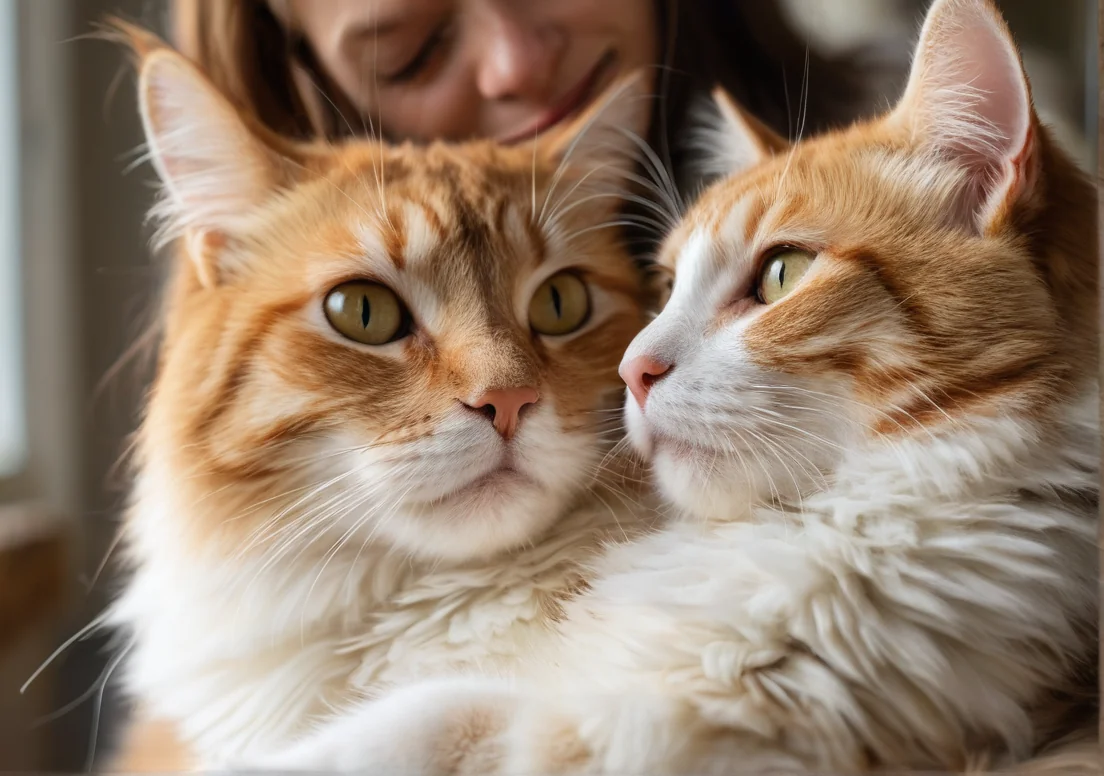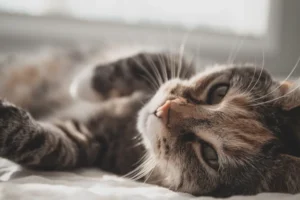Is your cat unexpectedly pulling out her fur? It’s a puzzling behavior that can leave pet owners scratching their heads. Understanding the reasons behind this can help you give your furry friend the attention she needs.
Your cat might be pulling her fur out due to stress, allergies, or skin issues, but this behavior can also stem from boredom or medical conditions. There’s so much more to unpack regarding this pesky problem, and you’ll want to uncover the secrets hidden below to ensure your cat regains her happy and healthy coat.

What Causes Cats to Pull Their Fur Out?
Cats can pull out their fur for a variety of reasons, and pinpointing the cause is crucial for resolving the issue. Psychological stress is often at the top of the list. Changes in the environment—like moving to a new home, the introduction of new pets or family members, or even changes in routine—can lead to anxiety and cause your cat to engage in excessive grooming.
Medical conditions can also play a significant role. Skin allergies or conditions such as fungal infections, parasites like fleas, or even more serious skin disorders can lead to fur loss. It’s also worth noting that pain from arthritis or internal issues may cause a cat to obsessively groom a specific area in an attempt to soothe itself.
Endocrine disorders, such as hyperthyroidism or Cushing’s disease, can create skin problems and fur loss as side effects. If your cat is suddenly pulling out fur or developing bald spots, it’s a good idea to consult with a vet to rule out these physical problems.
A unique angle to consider is the boredom factor. Indoor cats, especially those with limited stimulation, may resort to fur pulling as a way to entertain themselves. Ensuring they have plenty of toys, interactive playtime, and even a cozy window perch can help alleviate boredom and reduce the need for such behavior.
Is My Cat Stressed or Anxious?
Identifying stress in your cat isn’t as straightforward as it might be with dogs. Cats often display subtle signs of stress or anxiety that can manifest through fur pulling. Look for behaviors like hiding, excessive vocalization, or changes in eating habits.
A cat that suddenly becomes reclusive or avoids favorite spots may be trying to cope with anxiety. Body language is a big clue. If your cat’s tail is low or puffed up, or if they have dilated pupils, it’s a sure sign that something’s not quite right.
Psychological stress can stem from many sources. Sometimes, it’s simply environmental changes. Other times, something as subtle as restructured daily routines can lead to feelings of insecurity. Pay attention to these shifts, as they might provide insight into your cat’s behavior.
Regularly engaging with your cat through playtime and creating a safe, stable environment can significantly reduce stress levels. Consider using calming products such as pheromone diffusers or anxiety-relief treats to create a more soothing space.
In summary, knowing your cat’s normal behavior can help you spot the signs of stress and take proactive steps to help her feel more secure and comfortable.
Could Allergies Be the Culprit?
A common reason your cat might be pulling her fur out is due to allergies. These can stem from various sources, including food, environmental factors, and even flea bites.
Food Allergies : Cats can react to certain proteins, grains, or additives in their diet. If you’ve recently switched her food, that could be the trigger. Look for signs like itching, gastrointestinal issues, or skin irritations.
Environmental Allergies : Dust mites, pollen, and mold can irritate your cat’s skin. Pay attention to whether her fur-pulling coincides with certain seasons or activities around your home.
Flea Allergies : Even a single flea can cause significant distress. Cats sensitive to flea saliva might gnaw and bite their skin incessantly. Regular flea prevention is key here.
Identifying the exact trigger can take some time and patience. Keeping a detailed diary of her behavior and any changes you notice can be incredibly helpful for your vet. They’ll appreciate the insights when pinpointing the cause of her discomfort.
Are There Skin Conditions to Watch For?
Skin conditions can be a significant factor in why your cat is pulling her fur out. Not all fur loss is just a bad habit; some issues are more serious and require attention.
Dermatitis is a major culprit, often caused by contact irritants, allergies, or insect bites. Check for redness, swelling, or flaky skin, which are tell-tale signs. Apart from that, ringworm—a fungal infection—might be the issue. This can lead to circular patches of missing fur, and it’s contagious!
Miliary Dermatitis could also be at play. This condition often presents as small scabs and bumps, usually triggered by allergies. If you see these, it’s time to consult with your vet.
Additionally, parasites like mites or lice can irritate the skin, leading to excessive grooming and fur loss. A good rule of thumb is to keep an eye on any changes in her coat or behavior. If you notice significant fur loss or behavioral changes, it’s best to see a vet for a full evaluation. Early detection often leads to easier treatment!
Is Boredom a Factor?
Boredom can be a real culprit behind your cat’s fur-pulling antics. Cats need mental stimulation just as much as they need physical activity. Without enough enrichment, they might resort to grooming themselves excessively or engaging in odd behaviors.
To gauge if boredom’s at play, consider your cat’s environment. Is there enough variety? Interactive toys, climbing structures, and regular playtime can keep her engaged and stimulated. Try rotating toys, offering puzzle feeders, or even introducing new textures or scents with cat-safe plants or catnip. Cats are naturally curious creatures, so providing opportunities for them to explore and play can significantly reduce destructive behaviors.
How to Identify If It’s a Medical Issue?
If your cat’s pulling out her fur, it’s essential to rule out any potential health problems. Look for specific symptoms that may indicate something more serious, such as:
- Skin Irritation: Redness, bumps, or sores could point to allergies or infections.
- Changes in Appetite: A sudden change might signal stress or other health concerns.
- Behavior Changes: Increased aggression, withdrawal, or lethargy can suggest underlying issues.
- Excessive Grooming Patterns: If she’s not just pulling fur but is also obsessively grooming one area, take note.
Persistent or severe fur pulling could suggest the presence of parasites, food allergies, or even hormonal imbalances. If you notice any troubling symptoms, a visit to the vet is essential for a thorough evaluation. Keeping track of your cat’s routines and behaviors will help your vet provide the best care.
For a deeper look at potential causes, the American Animal Hospital Association provides excellent resources on animal health issues.
What Can I Do to Help My Cat?
If your cat’s tugging at her fur, it’s crucial to address the behavior sooner rather than later. Here are some practical tips to help:
Visit the Veterinarian: First up, schedule a check-up. Medical issues like allergies or skin infections can lead to fur pulling. A vet can rule out health problems.
Evaluate Her Environment: Stress might be the culprit. Look for anything that could be causing anxiety, like a new pet, loud noises, or changes in routine. Create a calm space with cozy hiding spots for her to retreat to.
Interactive Play: Make time for daily play. Toys that mimic prey behavior, like feather wands, can be great for mental stimulation and alleviate boredom. Engaging in regular interactive play can help reduce stress and distract her from grooming excessively.
Quality Grooming: Regular brushing can help if she’s over-grooming due to loose hair or mats. Choose a grooming routine that fits her coat type, which encourages bonding and reduces her urge to pull out her fur.
Introduce New Toys or Puzzles: Enrichment is key. Puzzle feeders or new toys can keep her mind busy, diverting her attention away from fur pulling.
Consider Anti-Anxiety Products: Feliway diffusers and calming collars can help soothe your cat if anxiety is a factor. These products mimic calming pheromones to create a relaxing environment.
Monitor Changes: Keep an eye on your cat’s behavior. If the pulling persists or worsens, follow up with your vet for further assessment.
By actively engaging in your cat’s health and environment, you can tackle the issue head-on and support her well-being effectively.
What Recent Research Says About Cats and Fur Pulling?
Recent studies have shed light on various feline behavioral patterns, particularly concerning over-grooming and fur pulling. One standout finding reveals a strong connection between stress and compulsive grooming behaviors.
According to a study published in the Journal of Feline Medicine and Surgery, cats experiencing chronic stress—stemming from changes in their surroundings or social structure—are more likely to engage in fur-pulling behavior.
Another intriguing angle explored the role of boredom. Research indicates that highly intelligent breeds, like Siamese or Abyssinians, might pull their fur out as an outlet for pent-up energy. Providing these cats with environmental enrichment—like climbing trees, toys, or even training—can significantly reduce such grooming issues.
Furthermore, findings suggest that compulsive grooming can sometimes symbolize a deeper emotional issue. Some cats may resort to this behavior to cope with feelings of insecurity or disruption in their daily lives.
For a deeper dive into the behavior-splicing and psychological aspects, refer to the studies highlighted at American Veterinary Medical Association AVMA. Understanding these nuances can help you tailor your approach to correctly address your cat’s fur-pulling tendency, ensuring her emotional and physical wellness.
What Should You Know About Managing Your Cat’s Environment?
Creating a stress-free environment is crucial for your cat’s overall well-being. If she’s pulling her fur out, it often signals underlying stress or discomfort. Start by evaluating her space. Is it quiet and relaxing? Cats thrive in calm settings, so consider minimizing loud noises and sudden changes.
Hiding spots are essential, as feral instincts drive cats to seek refuge. Providing cozy beds or boxes where she can retreat can make a world of difference. Layout matters too; ensure she has safe access to essential areas—food, water, and litter—while keeping them separated to avoid stress.
Another key factor is enrichment. Boredom can trigger anxious behavior, so stash away some toys to keep her engaged. Puzzle feeders can both challenge her mind and slow down her eating, promoting a more enjoyable mealtime.
Don’t overlook the importance of consistency in her routine. Cats love predictability; regular feeding times and play sessions foster a sense of security.
Consider air quality as well. Allergens can aggravate sensitive skin and even provoke fur pulling. Regular vacuuming and air purifiers can help keep her environment fresh.
Lastly, think about scent. Cats are sensitive to smells, so soothing scents like lavender or chamomile can help calm her down. Just ensure they’re cat-safe, as some essential oils are toxic.
By making these changes, you’re not just enhancing her living space; you’re also fostering a healthier, happier cat. Keep an eye on her behavior, and if fur pulling persists, consulting a vet is always a wise choice.
Alex, a passionate animal lover, has experience in training and understanding animal behavior. As a proud pet parent to two dogs and three cats, he founded AnimalReport.net to share insights from animal experts and expand his knowledge of the animal kingdom.




